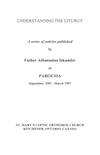
Understanding the Liturgy: Communion
In the early Church, communion was approached in the following way,
Coming up to receive, then, do not have your wrists extended or your fingers spread, but making your left hand a throne for the right, for it is about to receive a King, and cupping your palm, receive the body of Christ, and answer “Amen.” Carefully hallow your eyes by the touch of the sacred body and then partake, taking care to lose no part of it. After partaking of the body of Christ, approach also the cup of His blood. Do not stretch out your hands, but, bowing low in a posture of worship and reverence as you say “Amen,” sanctify yourself by partaking of the blood of Christ. While it is still moist upon your lips, touch it with your fingers, and so sanctify your eyes, your forehead and other senses. [107]
Taking communion in the hand is also evident from the writings of St. Dionysius, the 14thPope of Alexandria. [108]
To kneel or not to kneel?
Anyone observing communicants will see some kneeling at communion and others standing. Archibald king, who visited Egypt in the early 1920s observed that “Copts receive communion standing while Catholics normally receive kneeling.” [109] The same observation is made by Marquess de Bute. [110]
The Corporal:
The tradition of holding a small veil in the right hand to cover the mouth after receiving the body of the ord has an interesting history behind it. It goes back to the old days, when the Body was given to the communicants in their hands. It all started in the fourth century, when some rich ladies in Rome, out of reverence to the body of the Lord, made silken veils adorned with the cross and held them in their right hand in order to receive the body of Christ in it. These veils were called “corporals” from the Latin “corpus” which means body. The custom must have spread rapidly into the East (Constantinopolis and Alexandria.) Sometime in the middle ages, the Church in Egypt started to give communion directly into the mouth of the communicant. In spite of this, the habit of carrying a corporal in the right hand and raising it to the mouth, as if it contained the body of Christ, still survives!
Amen, Come Lord Jesus:
In the old times, when communion was over, and the priest raised the paten up high in commemoration of the ascension of the Lord, the people usually showed their yearning for the second coming of the Lord by saying, “Maranatha!” (O Lord come!) (ICor 16:22,) or “Amen, come Lord Jesus” (Rev 22:20). How and when and why did this essential part of the Anamnesis become replaced with “Glory to God in the highest” is a mystery. A proclamation of the Church’s yearning for the coming of the lord is in keeping with the Lord’s words, “For every time you shall eat of this bread and drink of this cup, you proclaim my death, confess my resurrection, and remember me till I come.” The same is also obvious from the priests words at the “oblation:” “as we also commemorate His holy passion, his resurrection from the dead, His ascension into the heavens and His sitting at Thy right hand O father, and his second coming from the heavens, awesome and full of glory …”
The exclamation, “Maranatha” or “Amen, come Lord Jesus” is the only part of the Liturgy where we commemorate the Lord’s second coming, and by doing so, we are faithful to His own admonition to us, “remember me till I come.”








